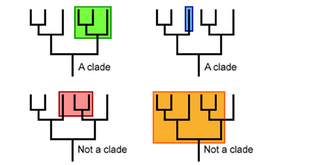
Cladistics

Figure 1. This shows some examples of clades and groupings that are not clades on a phylogenetic tree. Picture used from evolution.Berkeley.edu
What is a clade?[]
A clade is a group of species that have similar characteristics made up of an ancestor and all the descendants of that ancestor, no matter if those descendants are extant or extinct (Berkeley.edu, n.d.). A clade can also have many species in them or just a few. When looking at a phylogenetic tree, it is easy to pick out different clades.
Cladistics is the way scientists classify species into these clades or groups.
References:[]
Berkeley.edu. (n.d.). Evolution 101: Understanding phylogenies. Retrieved from http://evolution.berkeley.edu/evosite/evo101/IIBPhylogeniesp2.shtml
Cladogram[]
A cladogram is a diagram which shows the evolutionary relationships between two or more clades. Scientists look at shared character traits or morphology and try to figure out in what order the traits developed and which groups developed the traits at the same time or from a common ancestor (Nature Education, 2013). These diagrams and the relationships between clades that they illustrate are just guesses, many different configurations are sometimes possible. The cladist or scientist constructing a cladogram is searching for a format that shows the least number of changes in character traits (University of Edingurgh, n.d.). See the video below for a simple demonstration of creating a cladogram.

Cladograms
Costructing a Cladogram
References
University of Edinburgh. (n.d.). The Natural History Collection, Cladistics. Retrieved from http://www.nhc.ed.ac.uk/index.php?page=236.273.444
Nature Education (2013). Scitable Glossary. Retrieved from http://www.nature.com/scitable/definition/clade-269